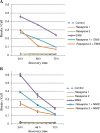Brahmarasayana protects against Ethyl methanesulfonate or Methyl methanesulfonate induced chromosomal aberrations in mouse bone marrow cells
- PMID: 22853637
- PMCID: PMC3457898
- DOI: 10.1186/1472-6882-12-113
Brahmarasayana protects against Ethyl methanesulfonate or Methyl methanesulfonate induced chromosomal aberrations in mouse bone marrow cells
Abstract
Background: Ayurveda, the traditional Indian system of medicine has given great emphasis to the promotion of health. Rasayana is one of the eight branches of Ayurveda which refers to rejuvenant therapy. It has been reported that rasayanas have immuno-modulatory, antioxidant and antitumor functions, however, the genotoxic potential and modulation of DNA repair of many rasayanas have not been evaluated.
Methods: The present study assessed the role of Brahmarasayana (BR) on Ethyl methanesulfonate (EMS)-and Methyl methanesulfonate (MMS)-induced genotoxicity and DNA repair in in vivo mouse test system. The mice were orally fed with BR (5 g or 8 mg / day) for two months and 24 h later EMS or MMS was given intraperitoneally. The genotoxicity was analyzed by chromosomal aberrations, sperm count, and sperm abnormalities.
Results: The results have revealed that BR did not induce significant chromosomal aberrations when compared to that of the control animals (p >0.05). On the other hand, the frequencies of chromosomal aberrations induced by EMS (240 mg / kg body weight) or MMS (125 mg / kg body weight) were significantly higher (p<0.05) to that of the control group. The treatment of BR for 60 days and single dose of EMS or MMS on day 61, resulted in significant (p <0.05) reduction in the frequency of chromosomal aberrations in comparison to EMS or MMS treatment alone, indicating a protective effect of BR. Constitutive base excision repair capacity was also increased in BR treated animals.
Conclusion: The effect of BR, as it relates to antioxidant activity was not evident in liver tissue however rasayana treatment was observed to increase constitutive DNA base excision repair and reduce clastogenicity. Whilst, the molecular mechanisms of such repair need further exploration, this is the first report to demonstrate these effects and provides further evidence for the role of brahmarasayana in the possible improvement of quality of life.
Figures


Similar articles
-
Combined mutagenicity of methyl methanesulfonate and ethyl methanesulfonate in Chinese hamster V79 cells.Mutat Res. 1992 Apr;266(2):171-80. doi: 10.1016/0027-5107(92)90184-4. Mutat Res. 1992. PMID: 1373826
-
Chromosomal analysis in mouse eggs fertilized in vitro with sperm exposed to ultraviolet light (UV) and methyl and ethyl methanesulfonate (MMS and EMS).Mutat Res. 1988 Mar;198(1):131-44. doi: 10.1016/0027-5107(88)90048-6. Mutat Res. 1988. PMID: 3352623
-
Studies on Brahma rasayana in male swiss albino mice: Chromosomal aberrations and sperm abnormalities.J Ayurveda Integr Med. 2010 Jan;1(1):40-4. doi: 10.4103/0975-9476.59826. J Ayurveda Integr Med. 2010. PMID: 21829300 Free PMC article.
-
Inducible protective processes in animal systems. X. Influence of nicotinamide in methyl methanesulfonate-adapted mouse bone marrow cells.Mutagenesis. 2002 Jan;17(1):1-8. doi: 10.1093/mutage/17.1.1. Mutagenesis. 2002. PMID: 11752227 Review.
-
Influence of mus201 and mus308 mutations of Drosophila melanogaster on the genotoxicity of model chemicals in somatic cells in vivo measured with the comet assay.Mutat Res. 2002 Jun 19;503(1-2):11-9. doi: 10.1016/s0027-5107(02)00070-2. Mutat Res. 2002. PMID: 12052499 Review.
Cited by
-
Antioxidant and anticlastogenic capacity of prickly pear juice.Nutrients. 2013 Oct 18;5(10):4145-58. doi: 10.3390/nu5104145. Nutrients. 2013. PMID: 24145870 Free PMC article.
-
Berberine attenuates XRCC1-mediated base excision repair and sensitizes breast cancer cells to the chemotherapeutic drugs.J Cell Mol Med. 2019 Oct;23(10):6797-6804. doi: 10.1111/jcmm.14560. Epub 2019 Jul 23. J Cell Mol Med. 2019. PMID: 31338966 Free PMC article.
-
Telomeres, DNA Damage and Ageing: Potential Leads from Ayurvedic Rasayana (Anti-Ageing) Drugs.J Clin Med. 2020 Aug 6;9(8):2544. doi: 10.3390/jcm9082544. J Clin Med. 2020. PMID: 32781627 Free PMC article.
-
Influence of Amalaki Rasayana on telomerase activity and telomere length in human blood mononuclear cells.J Ayurveda Integr Med. 2017 Apr-Jun;8(2):105-112. doi: 10.1016/j.jaim.2017.01.007. Epub 2017 Jun 9. J Ayurveda Integr Med. 2017. PMID: 28602428 Free PMC article.
-
Chitosan Nanoparticles Loaded with Capparis cartilaginea Decne Extract: Insights into Characterization and Antigenotoxicity In Vivo.Pharmaceutics. 2023 Oct 29;15(11):2551. doi: 10.3390/pharmaceutics15112551. Pharmaceutics. 2023. PMID: 38004531 Free PMC article.
References
-
- Rekha PS, Kuttan G, Kuttan R. Antioxidant activity of brahmarasayana. Indian J ExpBiol. 2001;39(5):447–452. - PubMed
Publication types
MeSH terms
Substances
LinkOut - more resources
Full Text Sources

